Henry Stanley, the Man Who Stole The Congo
The Victorian attitude to Africa was an unusual one. India they understood, they thought. India was a known quantity. But Africa…Africa was a mystery. There’s a phrase that’s used to describe those “uncorrupted” by civilisation – the Noble Savage. It’s an outwardly respectful term that under the surface heaves with contempt and unspoken superiority. To the Victorians, and the other Europeans of the 19th century, Africa itself was a Noble Savage. A land where the laws of civilisation, they felt, no longer applied to them. And in this belief were true monsters born.
Henry Morton Stanley, as he would later become, was born in Denbigh in northern Wales in 1841. His parents were not married, and his mother, a teenager named Elizabeth Parry, abandoned him to his father’s care shortly after his birth. His father’s name was John Rowlands, and that became his name as well. John senior was an alcoholic, however, and died when John junior was only two years old. His paternal grandfather had no interest in him, while his mother had at this stage decamped to London, so he was passed into the care of her relatives. At first his mother’s father, a butcher named Moses Parry, cared for him. Moses died when John was five, and he wound up in the workhouse, where he was beaten, bullied, and possibly sexually abused. At fifteen he ran away and got a job as an assistant school teacher, and then left Wales to go and stay with an aunt in Liverpool. There he decided to leave his country and even his name behind, and set off to the New World. [1]

John Rowlands arrived in New Orleans in 1859, where he found work as an assistant to a trader named Henry Hope Stanley – by, he later attested, walking up to him as he sat on his porch and asking for work. The two men became close, and the younger man decided to take the older man’s name – “John Rowlands” being the name of a father he despised, after all. [2] In 1862 Henry Morton Stanley (the name he would use for the rest of his life) decided to join the Confederate Army. This was less out of duty or desire for glory, and more due to social pressure. He had done his best to rid himself of his Welsh accent at this point, and claimed to be a native-born American – something which would greatly confuse later writers. He fought in the Battle of Shiloh, where General Ulysses S Grant succeeding in fighting off a surprise attack by the Confederates in what was the bloodiest battle of the war so far. Stanley was captured after the battle, and transported to Camp Douglas, near Chicago. This was the Union’s largest prisoner of war camp, and conditions were far from sanitary. Around 20% of the inhabitants of the camp would die from disease before the end of the war. Given that, and given his loose attachment to the Confederate cause, it’s not surprising that Stanley became a “Galvanised Yankee” – one of those in the POW camps who agreed to fight for the Union in exchange for their freedom. It’s also not surprising that he became ill after leaving the camp, and wound up being discharged from the Union Army on June 22nd, 1862 – less than three weeks after joining it. Once he recovered from his illness, Stanley found work as a sailor. He had worked his passage across from England, and so knew enough to make himself useful on board. At first he worked on merchant vessels, but in July 1864 he joined the US Navy, serving aboard the USS Minnesota. He was made the official ship’s record keeper, and discovered a talent for writing that opened his eyes to a new possible career. He would have been aboard the ship when it fought at the Second Battle of Fort Fisher, when the Union captured the last sea port in Confederate hands and cut them off from the global trade network. In February 1865 the Minnesota was decommissioned, and in April the war ended. [3]
After the war, Stanley determined to become a writer. His descriptions of the battles the Minnesota had participated in showed that he had a gift for it, and for the next year he travelled around the US as an itinerant newspaper correspondent. One incident where he fell in with a travelling theatrical company is notable, as he later attested it was the only time he had ever gotten drunk – he found the loss of control, not to mention the hangover the next morning, intolerable. His sensible habits meant that he was able to save up enough money to fund a trip to Asia with a friend named Cook, with the thought of writing a travelogue. He had planned to go as far into Asia as he could manage, but the first country he called at, the Ottoman Empire, turned out to be the last as well. A guide across the country betrayed the travellers and sold them to bandits, who stole all their money, beat them and nearly killed them out of hand. Persuaded against this, the kidnappers instead handed them over to the authorities on a trumped up charge in the hopes of gaining a reward. This turned out to be a mistake as a friend they had made on the way contacted the American ambassador and had the two freed (and eventually compensated). The two returned home. Technically the expedition had been a disaster – but, it turned out, it would lead to Stanley’s fame and fortune. In the short term, his writing about the expedition got him a job writing press releases (a relatively novel concept at the time) for the Indian Peace Commission, [4] followed by a job as an overseas correspondent for the New York Herald.
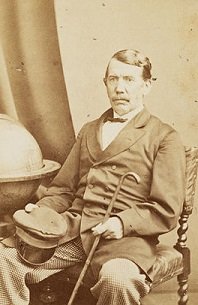
David Livingstone was a Scottish explorer, and a Victorian hero. In 1866 he had set out to find the source of the Nile and had not been heard from since. In 1869 Stanley was called into the office of the owner of the paper, James Gordon Bennett, and given one job with an unlimited budget – “Find Livingstone!” So it was that Stanley set off to Africa, on the expedition that would make his name. After spending a year or so tracking down rumours and speculation about Livingstone’s whereabouts, Stanley finally found a lead worth tracking down in Tanzania. In March 1871 he set out on a 700 mile journey through the jungle with over 200 native porters, including a young slave he had been given as a gift by an Arab. The six year old boy was named Ndugu M’Hali, but Stanley renamed him Kalulu [5] and made him his manservant. From accounts it sounds like he originally treated his employees well but the harsh nature of the expedition soon soured his disposition towards them. On 10th November 1871 the expedition reached the town of Ujiji on the shore of Lake Tanganyika, where the found Livingstone recuperating from an illness. On sighting Livingstone, the only white man for hundreds of miles, Stanley facetiously remarked:
Doctor Livingstone, I presume?
Or perhaps he didn’t. Livingstone didn’t record the remark, and Stanley destroyed his diary pages for the day the two met. Regardless, the remark became a legendary example of unflappability and helped to establish Stanley’s place in the mythology of African explorers. The pair jointly explored the region around Lake Tanganyika, and verified that it was not a tributary to the Nile. Stanley then left, and urged Livingstone to come with him. The old explorer refused, and insisted on continuing his search for the source of the Nile. He kept looking until he died a year and a half later. His body was brought back to England and buried in Westminster Abbey, but his heart was buried in Africa.
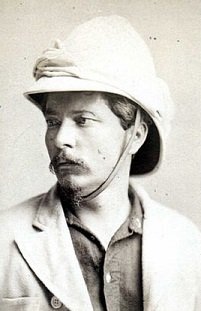
Stanley’s return and report of the meeting, along with the letters and papers from Livingstone he brought back, were a media sensation. His book, How I Found Livingstone, immediately established him in the public eye as one of the great African explorers. He returned to England, and brought Kalulu with him. By English law even though Kalulu had been a slave in Africa he was free as soon as he stepped on British soil. Stanley took him with him on a lecture tour to America and Paris, and then sent him to school in Wandsworth. While he was at school Stanley published a novel called My Kalulu, Prince, King and Slave, where a young Arab boy from a slave trading family is himself enslaved in Africa, and befriends a fellow slave named Kalulu. [6] The novel has a strongly anti-slavery message, as Stanley himself was at the time strongly against slavery. This would change. Stanley also became engaged to Alice Pike, the daughter of an American whisky distiller.
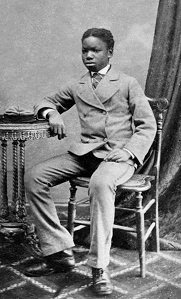
In 1874 the New York Herald and the Daily Telegraph commissioned Stanley to complete the work of the recently deceased Livingstone by charting the inlets and outlets of the known great central African lakes. He took Kalulu with him as an interpreter. The trip took three years, and while the first couple of years were broadly successful (mapping the perimeters of Lake Victoria and Lake Tanganyika) they were forced to give up the plan to map Lake Albert due to an ongoing war in the region. Stanley gained a reputation for violence towards the natives, however, and Sir Richard Burton commented that he shot the natives “as if they were monkeys”. However the last leg, mapping the course of the Lualaba River, was a much more dicey affair. It took them through unknown territory, and territories known to be unfriendly to outsiders. Stanley’s goal was to show that the river was a tributary of the Congo River, and in this he succeeded. After over 1200 miles of river, the final obstacle the expedition faced was thee Livingstone Falls – 155 miles of waterfalls and rapids. There were several lives lost in the descent, including that of Kalulu. In August 1877 the expedition finally made it back to Zanzibar, nearly three years after they had set out. Stanley sent his dispatches to his publisher, and received in return the news that Alice had married another man. [7]
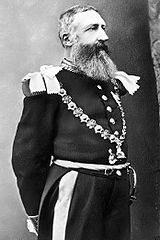
Stanley’s book describing the journey, Through The Dark Continent, was a great success. One of those who read it was King Leopold II of Belgium, who had ambitions of establishing African colonies for his country. The untamed land Stanley described sounded, to him, like an ideal candidate. Stanley had been trying, and failing, to persuade the British authorities to commission him to bring the region under their control, but had been having little luck – most regarded him as an “upstart American”, ironically. (His American backers wanted to send him off on a polar expedition, which he was less than enthused about.) Leopold was the answer to Stanley’s prayers. At the time the region was under the nominal control of Portugal, but Leopold managed (under the cover of a plan to civilise the region and dismantle the slave trade) to gain international support for taking over the region. While this was going on in 1879 Stanley led an expedition though the Congo basin for the King, building roads, establishing steamship ports on the river, and persuading native rulers to sign away their rights to their lands. Even by the standard of his time Stanley was considered brutal – shooting natives for the the smallest provocation, looting stores of ivory, and giving people a foretaste of the new bloody regime.
By 1884 Stanley had established the foundations of the Congo Free State. The “Free State” was in truth little more than a slave economy on a widespread scale, where all lives were in Leopold’s gift. The main output of the region was rubber, which Europe had an insatiable appetite for. Failure to meet one’s rubber quota was punishable by death, proven by delivering the dead man’s right hand. Villages unable to meet their quotas would go to war to harvest hands to deliver instead. It’s estimated that the country Stanley created led to the death of 10 million people – half the population of the region – over the next 20 years.
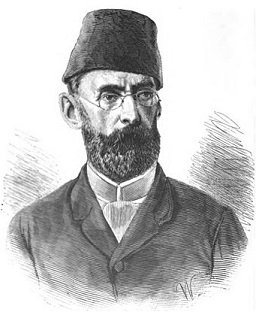
The excesses of Leopold’s rule in the Congo soon became apparent, and the Belgian monarch would fight a propaganda war for the rest of his reign. Stanley, too, suffered in the public eye. Fortunately for him, there was an opportunity to redeem himself. Unfortunately it would turn into such a debacle that it would end the era of African expeditions forever. The opportunity came when the Mahdists (an Islamic sect of apocalyptists) raised a rebellion in the Sudan. Their conquests led to the isolation of the Egyptian province of Equatoria, on the northern shore of Lake Albert. The governor of the region, a German doctor named Emin Pasha, had appealed to the British for assistance, but the British government had their hands full fighting the Mahdists. The British press, however, played up Pasha’s plight. The Scottish businessman William McKinnon, who had made his fortune through colonial trading, decided to organise a relief expedition. He recruited Stanley to lead it, and Stanley was quick to make clear in the press that this was a mission of mercy.
The expedition is non-military–that is to say, its purpose is not to fight, destroy, or waste; its purpose is to save, to relieve distress, to carry comfort.
They left London in January 1887 to widespread public acclaim, and in May they arrived in Leopoldville (the capital of the Congo region that Stanley had established in 1881, nowadays called Kinshasa). On the 1st June the advance column of 389 men set out for Lake Albert. They expected the journey to take two months – it took nearly six, and claimed the lives of 220 men. Worse, when they reached Lake Albert they could not find Emin Pasha. The rear column, which was supposed to establish their route home, collapsed into infighting and was almost completely lost. Eventually they located him, only to find that he did not want to leave. However the rumours that he was planning to abandon his men led to a mutiny, and he was forced to leave with them. With their route back down the Congo cut off they were forced to head south and hope for the best. In a stroke of luck for them though the German Army had moved into Tanzania and colonised the country while they had been on the expedition, so they had a much easier time getting out than they had getting in. It was the end of 1889 before they finally made it back to the coast, where the expedition broke up. Stanley stopped off in Cairo for a couple of months, where he wrote In Darkest Africa, his story of the expedition.
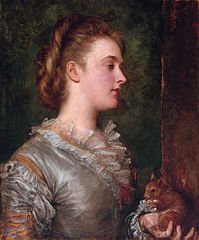
Stanley returned to London in May 1890 to initial huge acclaim, and married a Welsh artist named Dorothy Tennant. However the public mood soon soured on Stanley. The huge number of casualties among the expedition soon became apparent, but worse was the controversy caused by Stanley’s account of the expedition. In it he castigated two of the commanders of the rear column, James Jameson (heir of the Jameson whisky family, and known as Sligo) and Edmund Barttelot. Both had died on the expedition, and the family found the accounts of their conduct given by Stanley somewhat objectionable. The tales of Barttelot abusing the natives until one finally knifed him were bad enough, but the story of Sligo Jameson was far worse. According to Stanley (and later substantiated by his own diary), before he died of a fever Sligo had been taking notes on native customs. In furtherance of this, he had bought a young girl from a slave trader, and given her to a group of cannibals in exchange for being allowed to watch them eat her. The scandal clung to the Jameson name for years, and led to Jamesons being referred to as “cannibal whiskey”.
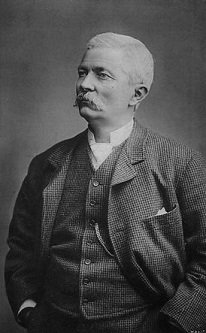
The Emin Pasha Relief Expedition was the last of the African expeditions, and Stanley found himself in a somewhat reluctant retirement from the adventuring life. He was fifty years old, after all, and his health had suffered somewhat over the years. In 1895 he became a Liberal MP, and in 1899 a Knight of the Order of the Bath. His reputation improved, and America and Britain both competed to claim him as a native son. Some stigma still remained however – when he had requested that he be buried in Westminster Abbey, but when he died in 1904 this was refused. Instead he was buried in Pirbright, Surrey. His epitaph read “Bula Matari” – in Kikongo, the “Breaker of Stones”.
Stanley’s autobiography was published by his widow in 1909, and his story of his Welsh origins was rapidly accepted by a public that had transformed him into a part of the romanticised history of African exploration. In later years, as the true extent of the horrors of Leopold’s Congo became apparent, that history soon began to unravel. In 2010 Denbigh in Wales, where Stanley had claimed to have been born, honoured its most famous son with a statue in the town despite fierce protests from those who regarded him as a symbol of European arrogance and aggression. To this day his statue is the focus of protest, with the face frequently being painted white – a symbolic representation of the “whitewashing” of history. On several occasion the statue has been clad in a rubber body bag by a group of artists in protest. Yet still, the local people are proud of the statue, and proud of their native son. And if he did do those terrible things – it was in Africa. Where there were no rules.
Images via wikimedia.
[1] A caveat. While the rest of Stanley’s life is reasonably well attested, the information in this paragraph comes largely (directly or indirectly) from Stanley’s biography. Stanley, unfortunately, was a notable fantasist and compulsive liar. As such, some scholars doubt the veracity of several of these facts (for instance, several believe that Stanley’s father was a married lawyer named James Vaughan Horne).
[2] Modern historians often question Stanley’s sexuality, based on some episodes later in his life. As such, the fact that he became such a close confidante of Henry Hope Stanley so quickly, and took on his name, could be subject to an entirely different reading in modern times. It’s also suggestive that he would later claim that the older man died in 1861, when according to local records he survived until 1878.
[3] Stanley would later claim to have “jumped ship” on the 10th of February, but this was probably a later exaggeration.
[4] The “Indians” in question being Native Americans.
[5] Which means “Baby Antelope”, at least according to Stanley. He reportedly almost called the boy “Munro”, possibly after a notoriously anti-slavery British governor in India the previous century, but was told the pro-slavery locals would not appreciate the joke.
[6] The relationship between Stanley and Kalulu is another point of contention, with some historians pointing to the homoerotic undertones of My Kalulu as evidence of a relationship between the two. There is no actual evidence of any kind for this, however.
[7] Alice Pike Barney, as she became, would become a pivotal figure in the American art world.
